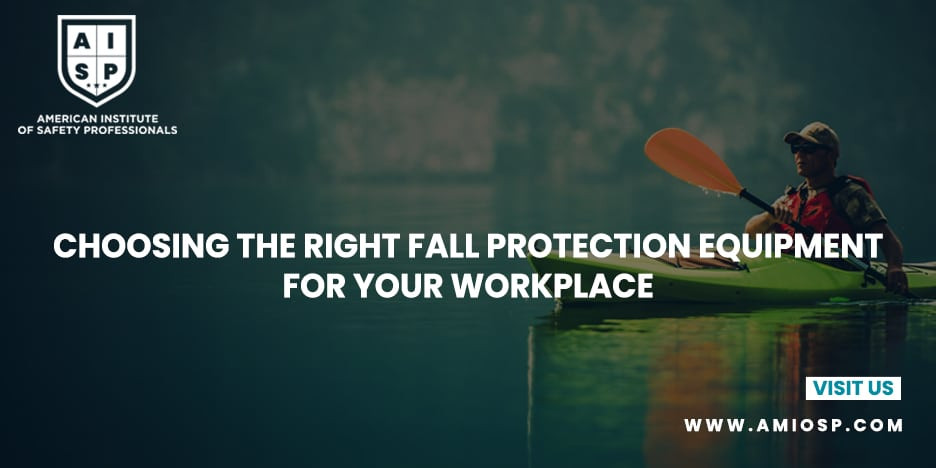In any industry or workplace where employees are exposed to
fall hazards, selecting the right fall protection equipment is crucial. Fall
protection plays a vital role in preventing injuries and fatalities, and it is
the responsibility of employers to provide their workers with appropriate and
effective safety equipment. However, with the wide range of options available,
choosing the right fall protection equipment can be a daunting task. In this
blog post, we will discuss key considerations and provide valuable insights to
help you make informed decisions when selecting fall protection equipment for
your workplace.
Assessing Workplace Hazards
Before selecting fall protection equipment, it is essential
to conduct a thorough assessment of the workplace to identify potential fall
hazards. Consider the nature of the work being performed, the height at which
workers will be operating, and the specific tasks involved. Some common fall
hazards include working on elevated platforms, roofs, scaffolding, ladders, and
in confined spaces. Understanding these hazards will guide you in determining
the appropriate types of fall protection equipment needed for your workplace.
Understanding the Hierarchy of Fall Protection
The hierarchy of fall protection provides a framework for
selecting the most suitable fall protection equipment based on the level of
hazard and risk. The hierarchy typically consists of four levels:
1. Elimination/Substitution: The first level focuses
on eliminating or substituting fall hazards altogether. This can involve
engineering controls or modifying work processes to eliminate the need for
workers to be exposed to fall risks. While this is the most effective approach,
it may not always be feasible or practical.
2. Passive Fall Protection: The second level involves
implementing passive fall protection measures that do not require worker
intervention. This includes installing guardrails, barriers, safety nets, and
warning signs. Passive fall protection measures create physical barriers to
prevent falls and provide an added layer of protection.
3. Fall Restraint: Fall restraint systems prevent
workers from reaching the edge or fall hazard by using anchor points and body
harnesses. These systems limit the worker's movement and keep them at a safe
distance from the edge. Fall restraint systems are particularly useful in
situations where falls cannot be eliminated or substituted.
4. Fall Arrest: Fall arrest systems are designed to
arrest a worker's fall in case they do slip or fall. These systems consist of
components such as full-body harnesses, lanyards, and anchor points. Fall
arrest systems must be properly designed, installed, and maintained to ensure
their effectiveness in protecting workers from serious injuries.
Understanding the hierarchy of fall protection will guide
you in selecting the most appropriate equipment for your workplace, based on
the level of protection required.
Types of Fall Protection Equipment
There are several types of fall protection equipment
available in the market, each serving specific purposes and catering to
different workplace scenarios. Here are some key types of fall protection
equipment to consider:
1. Harnesses: Full-body harnesses are a fundamental
component of fall protection systems. They distribute fall forces throughout
the body and provide support in the event of a fall. When selecting harnesses,
consider factors such as comfort, adjustability, and the number of attachment
points required for specific work tasks.
2. Lanyards: Lanyards connect the worker's harness to
an anchor point, providing a secure connection while allowing limited movement.
There are different types of lanyards available, including shock-absorbing
lanyards that reduce the impact of a fall. Consider factors such as length,
type of attachment, and energy absorption capacity when choosing lanyards.
3. Anchor Points: Anchor points are attachment points
that connect the worker's fall protection equipment to a secure structure or
anchor system. Anchor points must be capable of supporting the anticipated load
and be properly installed according to manufacturer instructions and industry
standards.
4. Self-Retracting Lifelines (SRLs): SRLs are
retractable devices that allow workers to move freely while automatically
retracting the lifeline in the event of a fall. They provide continuous fall
protection and minimize fall distances, reducing the risk of injury. Consider
factors such as lifeline length, weight capacity, and locking mechanisms when
choosing SRLs.
5. Guardrails and Barriers: Guardrails and barriers
are passive fall protection systems that provide a physical barrier to prevent
falls. They are commonly used in elevated work areas, roofs, platforms, and
construction sites. Consider factors such as height, strength, durability, and
compliance with industry standards when selecting guardrails and barriers.
6. Safety Nets: Safety nets are passive fall
protection systems designed to catch workers in the event of a fall. They are
particularly useful when guardrails and other measures are impractical. Safety
nets should be installed close to the working area and meet specific
performance standards to ensure their effectiveness.
7. Rescue Equipment: In addition to fall protection
equipment, it is crucial to have appropriate rescue equipment readily available
in case of a fall. This may include retrieval systems, descent devices, and
personnel trained in rescue procedures. Quick and effective rescue is essential
for minimizing the potential injuries resulting from a fall.
Ensuring Compliance and Training
Once you have selected the appropriate fall protection
equipment, it is crucial to ensure compliance with manufacturer guidelines,
industry standards, and regulatory requirements. Regular inspections,
maintenance, and proper storage of equipment are essential to preserve their
effectiveness and longevity. Additionally, comprehensive training programs
should be provided to workers, ensuring they understand the proper use,
inspection, and limitations of fall protection equipment. Workers should be
trained in identifying fall hazards, donning and adjusting equipment, and
responding to emergencies.
Conclusion
Selecting the right fall protection equipment is vital for
safeguarding workers from fall hazards in the workplace. By assessing workplace
hazards, understanding the hierarchy of fall protection, and considering the
types of equipment available, employers can make informed decisions. Remember
to ensure compliance with regulations, conduct regular equipment inspections,
and provide thorough training to workers. Investing in appropriate fall
protection equipment not only protects workers' lives but also demonstrates a
commitment to safety and compliance within your organization.












0 comments
No Comments